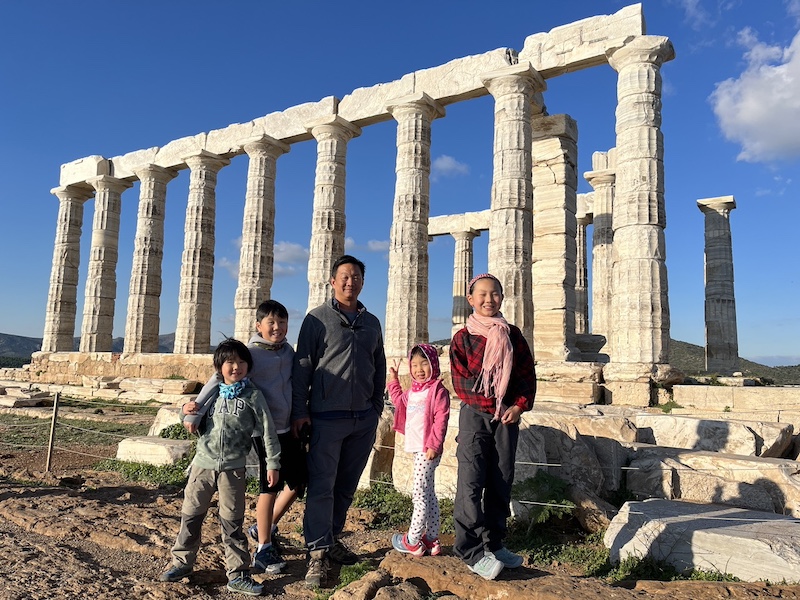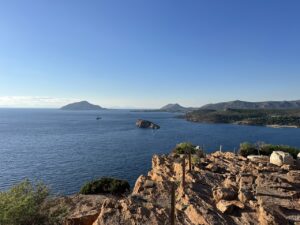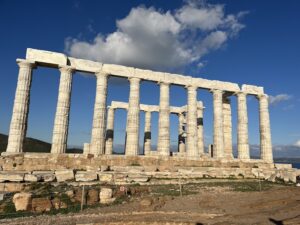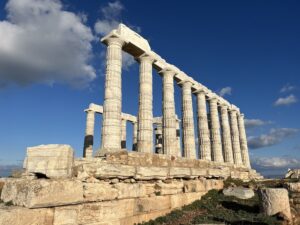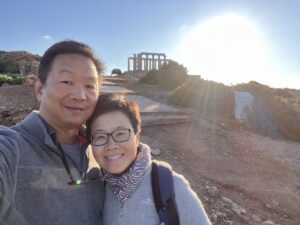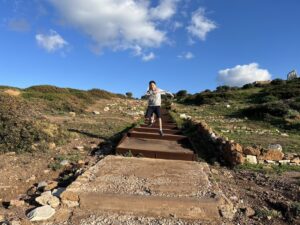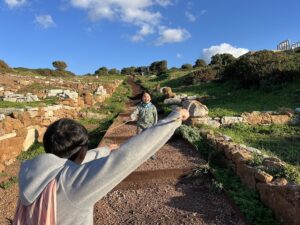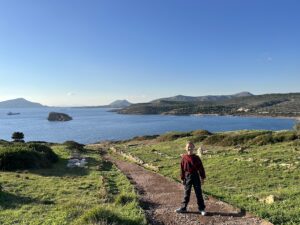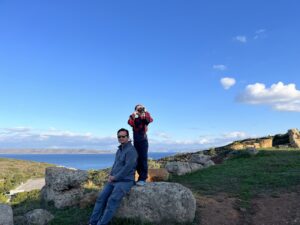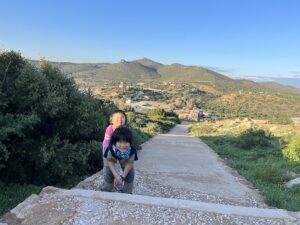We made the 4-hour drive from Nafplio to Cape Sounion, where the Temple of Poseidon sits about 65 meters above the sea on a rugged cliff. In ancient times, departing sailors would have watched Cape Sounion and the Temple of Poseidon disappear into the distance as they sailed fearlessly into the depths of the Aegean Sea.
We arrived at dusk when the sun was beginning to set, casting a golden glow on everything that it touched. Besides us, there was not a single soul at the temple, so we had the entire place to ourselves. The temple and the surrounding views are just simply stunning. It was here that I felt the spirit of Greek mythology come alive.
Before me, I could see a grief-filled King Aegeus jumping to his death into the bay when he believed his son, Theseus, had been killed by the Minotaur. Father and son had agreed that if Theseus was victorious in slaying the Minotaur, he would sail home with white sails. Upon seeing black sails, King Aegeus was mad with grief, believing his son had been defeated and killed by the Minotaur. Theseus had won the battle but had simply forgotten to raise the white sails, resulting in the suicide of his father.
The temple itself was built in the middle of the 5th century BC, though the area was inhabited as early as 2800 BC. The temple is dedicated to Poseidon, god of the sea and second only in power to his brother, Zeus. In its day, the temple housed a massive six-meter-tall bronze statue of Poseidon. Sailors and fishermen would worship at the temple with offerings of animal sacrifices and other gifts so keep them safe from storms and shipwrecks while they were at sea.
Over the centuries, the Temple of Poseidon and the surrounding area fell victim to the ravages of time. There were likely a series of tsunamis or earthquakes that contributed to its destruction. In the end, the magnificent temple of white marble failed to appease the god of the sea.
The rectangular shape of the Temple of Poseidon resembles the Temple of Hephaestus at the Ancient Agora that we visited in Athens though the Temple of Hephaestus is in much better condition. Similar to the friezes at the Temple of Hephaestus, one of the friezes the Temple of Poseidon’s depicted the story of Theseus and the Battle of the Centaurs. Archaeologists believe the Parthenon, the Temple of Hephaestus and the Temple of Poseidon all shared the same architect.
After admiring the temple under the retreating sun, we followed a path that led to the sea. AY and I descended the path hand-in-hand, inhaling the fresh sea air. RY and DY drank in the chaos of the wind and the drama of the sea and amidst the ancient ruins, they transformed into warriors, heroes and philosophers. They donned capes, forged weapons and pretended to defeat enemies, defy gravity and battle each other.
We wandered around the remains of the ancient town on the hillside below the temple. With the help of some informational plaques, we could make out the dimensions of the street and some fo the foundations of homes and storerooms for the port that once stood there.
Sunset at the Temple of Poseidon is considered to be among the best sunsets in Greece, rivaling the sunset on Santorini. Although we wanted to, we couldn’t stay long enough to watch the sky turn into an impressionist painting. In my mind’s eye, I could already see the sky bathed in the golden glow of the retiring sun with splashes of Tyrian purple and coral pink.
Ahead of us, we still had a two-hour drive back to Athens to board the overnight ferry to Crete
Author
-

Song is the mother of four children. She and her family have stepped away from it all and in September 2023, began traveling the world while homeschooling. Song is an ABC (American born Chinese) and has an undergraduate degree from Cornell and an MBA from Harvard. She is an entrepreneur and an educator. Her hobbies include learning, traveling, reading, cooking and baking, and being with children.

